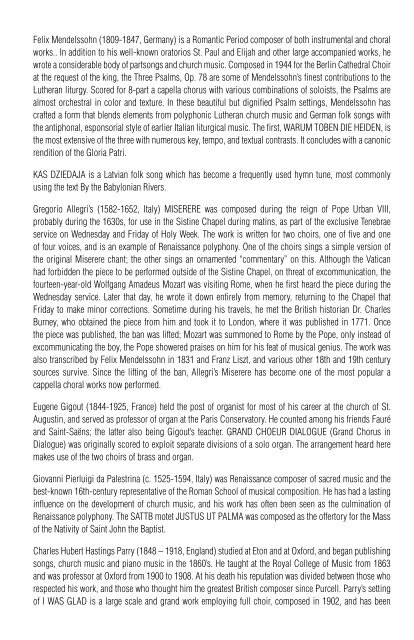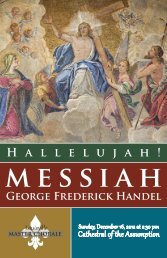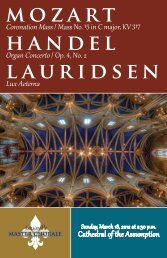program - The Louisville Master Chorale
program - The Louisville Master Chorale
program - The Louisville Master Chorale
Create successful ePaper yourself
Turn your PDF publications into a flip-book with our unique Google optimized e-Paper software.
Felix Mendelssohn (1809-1847, Germany) is a Romantic Period composer of both instrumental and choral<br />
works.. In addition to his well-known oratorios St. Paul and Elijah and other large accompanied works, he<br />
wrote a considerable body of partsongs and church music. Composed in 1944 for the Berlin Cathedral Choir<br />
at the request of the king, the Three Psalms, Op. 78 are some of Mendelssohn’s finest contributions to the<br />
Lutheran liturgy. Scored for 8-part a capella chorus with various combinations of soloists, the Psalms are<br />
almost orchestral in color and texture. In these beautiful but dignified Psalm settings, Mendelssohn has<br />
crafted a form that blends elements from polyphonic Lutheran church music and German folk songs with<br />
the antiphonal, esponsorial style of earlier Italian liturgical music. <strong>The</strong> first, WARUM TOBEN DIE HEIDEN, is<br />
the most extensive of the three with numerous key, tempo, and textual contrasts. It concludes with a canonic<br />
rendition of the Gloria Patri.<br />
KAS DZIEDAJA is a Latvian folk song which has become a frequently used hymn tune, most commonly<br />
using the text By the Babylonian Rivers.<br />
Gregorio Allegri’s (1582-1652, Italy) MISERERE was composed during the reign of Pope Urban VIII,<br />
probably during the 1630s, for use in the Sistine Chapel during matins, as part of the exclusive Tenebrae<br />
service on Wednesday and Friday of Holy Week. <strong>The</strong> work is written for two choirs, one of five and one<br />
of four voices, and is an example of Renaissance polyphony. One of the choirs sings a simple version of<br />
the original Miserere chant; the other sings an ornamented “commentary” on this. Although the Vatican<br />
had forbidden the piece to be performed outside of the Sistine Chapel, on threat of excommunication, the<br />
fourteen-year-old Wolfgang Amadeus Mozart was visiting Rome, when he first heard the piece during the<br />
Wednesday service. Later that day, he wrote it down entirely from memory, returning to the Chapel that<br />
Friday to make minor corrections. Sometime during his travels, he met the British historian Dr. Charles<br />
Burney, who obtained the piece from him and took it to London, where it was published in 1771. Once<br />
the piece was published, the ban was lifted; Mozart was summoned to Rome by the Pope, only instead of<br />
excommunicating the boy, the Pope showered praises on him for his feat of musical genius. <strong>The</strong> work was<br />
also transcribed by Felix Mendelssohn in 1831 and Franz Liszt, and various other 18th and 19th century<br />
sources survive. Since the lifting of the ban, Allegri’s Miserere has become one of the most popular a<br />
cappella choral works now performed.<br />
Eugene Gigout (1844-1925, France) held the post of organist for most of his career at the church of St.<br />
Augustin, and served as professor of organ at the Paris Conservatory. He counted among his friends Fauré<br />
and Saint-Saëns; the latter also being Gigout’s teacher. GRAND CHOEUR DIALOGUE (Grand Chorus in<br />
Dialogue) was originally scored to exploit separate divisions of a solo organ. <strong>The</strong> arrangement heard here<br />
makes use of the two choirs of brass and organ.<br />
Giovanni Pierluigi da Palestrina (c. 1525-1594, Italy) was Renaissance composer of sacred music and the<br />
best-known 16th-century representative of the Roman School of musical composition. He has had a lasting<br />
influence on the development of church music, and his work has often been seen as the culmination of<br />
Renaissance polyphony. <strong>The</strong> SATTB motet JUSTUS UT PALMA was composed as the offertory for the Mass<br />
of the Nativity of Saint John the Baptist.<br />
Charles Hubert Hastings Parry (1848 – 1918, England) studied at Eton and at Oxford, and began publishing<br />
songs, church music and piano music in the 1860’s. He taught at the Royal College of Music from 1863<br />
and was professor at Oxford from 1900 to 1908. At his death his reputation was divided between those who<br />
respected his work, and those who thought him the greatest British composer since Purcell. Parry’s setting<br />
of I WAS GLAD is a large scale and grand work employing full choir, composed in 1902, and has been<br />
performed at all of the coronations since then, being sung at the arrival of the monarch. <strong>The</strong> work is scored<br />
for two SATB choirs.<br />
Leonard Bernstein (1918-1990, America) composed the CHICHESTER PSALMS in 1965 for boy treble,<br />
solo quartet, choir and orchestra. <strong>The</strong> work was commissioned for the 1965 Southern Cathedrals Festival at<br />
Chichester Cathedral. <strong>The</strong> world premiere, however, took place in the Philharmonic Hall, New York, on July<br />
15, 1965 with the composer conducting, followed by the performance in the Chichester Festival on July 31,<br />
conducted by John Birch. <strong>The</strong> Psalms and the first movement in particular are noted among performers for<br />
their musical difficulty, with the opening section of the first movement often considered one of the hardest<br />
passages for choral tenors ever written, owing to the range of the piece, its rhythmic complexity and the<br />
consistent presence of the strange and difficult-to-maintain parallel 7ths between the tenor and bass parts.<br />
Despite the work’s difficulty, it is occasionally performed as an anthem in services of choral Evensong in the<br />
most musical Anglican cathedrals.<br />
– Program notes by David Paul Gibson






